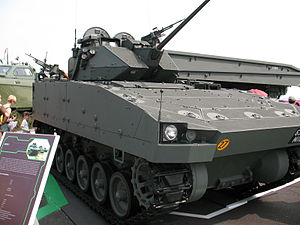Bionix AFV
| Bionix Infantry Fighting Vehicle | |
|---|---|

Bionix II IFV at the 2008 Singapore Airshow.
|
|
| Type | Infantry fighting vehicle |
| Place of origin | Singapore |
| Service history | |
| In service | 1997 - present |
| Used by | See Operators |
| Production history | |
| Designer | ST Kinetics |
| Designed | 1988 |
| Manufacturer | ST Kinetics |
| Produced | 1996 - present |
| Variants | See Production models |
| Specifications | |
| Weight | Combat weight: 23 tonnes (25 short tons; 23 long tons) |
| Length | 5.9 metres (19 ft 4 in) |
| Width | 2.7 m (8 ft 10 in) |
| Height | 2.6 m (8 ft 6 in) |
| Crew | 3 (Commander, Gunner, Driver) plus 7 combat troops (2 men turret version) 9 combat troops (40/50 version) |
|
|
|
| Armor | MEXAS-M |
|
Main
armament |
Bionix 25: M242 Bushmaster 25 mm Cannon Bionix II: Mk44 Bushmaster II 30 mm Cannon |
|
Secondary
armament |
7.62×51mm NATO Commander's Coaxial MG 7.62×51mm NATO Coaxial MG 7.62×51mm NATO Trooper Compartment Side Mounted GMPG |
| Engine |
Detroit Diesel Corporation (DDC) 6V 92TA 475 horsepower (354 kW) 550 hp (410 kW) with Turbo-charge |
| Power/weight | 20 hp/tonne |
| Suspension | Hydropneumatic suspension |
|
Operational
range |
400 km (250 mi) |
| Speed | 70 km/h (43 mph) |
The Bionix (BX) is a family of tracked Singaporean armoured fighting vehicles developed by Singapore Technologies Kinetics (formerly Singapore Technologies Automotive, which is now known as Singapore Technologies Engineering). Intended to augment the Singapore Army's aging M113 armoured personnel carriers, it is the first indigenous armoured vehicle to be developed in Southeast Asia. The Bionix has been operational with the Singapore Armed Forces (SAF) since 1999 in a wide variety of adaptations including the Bionix II, Bionix 25 and Bionix 40/50 variants.
Aside from domestic use, ST Kinetics has been marketing the Bionix to countries that wish to retire their old M113s from front-line service.
Along with the growth and development of the Singapore Armed Forces (SAF) during the mid 1980s came a need to bolster (and eventually replace) the existing fleet of M113 Armored Personnel Carriers (APCs). This prompted the Ministry of Defence (MINDEF) to source for a fleet of armored vehicles to operate in tandem with the current fleet of AMX-13 SM1 light tanks.
With the participation of the SAF, the Defence Materiel Organisation (DMO), MINDEF's systems acquisition house, was appointed to conduct a technology study and recommend the direction for the project. A market survey was conducted in which various armored vehicles including the Warrior Tracked Armoured Vehicle, the M2/M3 Bradley Fighting Vehicle, and the Schützenpanzer Marder were evaluated. The findings from the market survey showed that none of the off-the-shelf vehicles met the specific requirements of the SAF. Therefore, the decision was made to develop a vehicle locally. Local development was necessary not only because of a lack of suitable off-the-shelf designs, but also as an opportunity to build up the capability of the local defense industry. Known as "BIONIX", the IFV was the product of a tripartite team of engineers and technical staff from Singapore Technologies Automotive, DMO and G5 Army, working jointly with HQ Armour to produce a fighting machine tailored to the specific operational requirements of the Army. Key considerations during the design process included high mobility and agility, low weight, amphibious capability, and adequate protection and firepower.
...
Wikipedia
